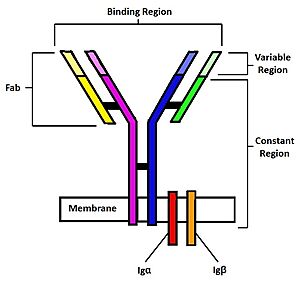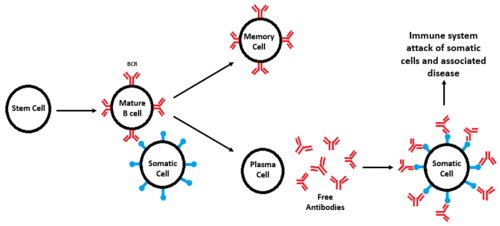Sandbox Reserved 1771
From Proteopedia
(Difference between revisions)
| Line 14: | Line 14: | ||
===Fc and α/β Interactions=== | ===Fc and α/β Interactions=== | ||
| - | While the antigen binding site structure of the mIgM BCR is identical to common soluble antibodies, intermolecular interactions between the heavy chains and Igα/β subunits provide the emergent receptor properties. In the Fc portion of the structure, the two heavy chains interact via a disulfide bond and form an <scene name='95/952700/O-shaped_ring/ | + | While the antigen binding site structure of the mIgM BCR is identical to common soluble antibodies, intermolecular interactions between the heavy chains and Igα/β subunits provide the emergent receptor properties. In the Fc portion of the structure, the two heavy chains interact via a disulfide bond and form an <scene name='95/952700/O-shaped_ring/17'>O-shaped ring</scene>. Additionally, the Fc portion binds the <scene name='95/952700/O-shaped_ring/13'>Ig α/β heterodimer</scene> <scene name='95/952700/O-shaped_ring/15'>(heterodimer zoomed)</scene> with 1:1 stoichiometry. <Ref name="Tolar P"> Tolar P, Pierce SK. Unveiling the B cell receptor structure. Science. 2022 Aug 19;377(6608):819-820. [doi: 10.1126/science.add8065. Epub 2022 Aug 18. PMID: 35981020.] </Ref>. Due to the orientation of the heavy chains in the O-shaped ring, only Heavy chain 1 (Hc1) forms direct interactions with the Igα/β heterodimer. To correspond with the 3D representations, Hc1 residues will be represented in blue, Igα residues will be represented in red, and Igβ residues will be represented in orange. Furthermore, <scene name='95/952700/Ig-a_and_hc_1/6'>Hc1 and Igα interact</scene> through two hydrogen bonds (<b><span class="text-red">T75</span></b>-<b><span class="text-blue">Q487</span></b> and <b><span class="text-red">N73</span></b>-<b><span class="text-blue">Q493</span></b>) which are stabilized by sandwiching of aromatic residues (<b><span class="text-red">W76</span></b> sandwiched between <b><span class="text-blue">F358</span></b> and <b><span class="text-blue">F485</span></b>). Similarly, <scene name='95/952700/Igb_and_hc/6'>Hc1 and Igβ interact</scene> through three hydrogen bonds (<b><span class="text-orange">Y66</span></b>-<b><span class="text-blue">R491</span></b>, <b><span class="text-orange">K62</span></b>-<b><span class="text-blue">T530</span></b>, and <b><span class="text-orange">R55</span></b>-<b><span class="text-blue">T533</span></b>). The residues involved in the interactions at the heavy chain and Igα/β interface are highly conserved across all species, suggesting a conserved mode of interaction. <Ref name="Su Q"> Su Q, Chen M, Shi Y, Zhang X, Huang G, Huang B, Liu D, Liu Z, Shi Y. Cryo-EM structure of the human IgM B cell receptor. Science. 2022 Aug 19;377(6608):875-880. [doi: 10.1126/science.abo3923. Epub 2022 Aug 18. PMID: 35981043.]</Ref>. The Igα/β heterodimer is composed of a transmembrane domain, which consists of two hydrophobic helices, and an extracellular domain, which forms an interface with and Hc1. The Igα/β heterodimer is an obligate component of all BCRs. Igα and Igβ non-covalently associate with mIgM, and are crucial components for initiating biochemical signaling inside the B cell upon antigen binding. <Ref name="Tolar P"> Tolar P, Pierce SK. Unveiling the B cell receptor structure. Science. 2022 Aug 19;377(6608):819-820. [doi: 10.1126/science.add8065. Epub 2022 Aug 18. PMID: 35981020.] </Ref>. <scene name='95/952700/Iga_and_igb/4'>Igα and Igβ are connected</scene> by a disulfide bond between cystine residues (<b><span class="text-red">C119</span></b>-<b><span class="text-orange">C136</span></b>). The disulfide bond is further stabilized by π-π stacking (<b><span class="text-red">Y122</span></b> and <b><span class="text-orange">F52</span></b>) and a hydrogen bond (<b><span class="text-red">G120</span></b>-<b><span class="text-orange">R51</span></b>). These residues in Igα/β are highly conserved across species, suggesting conservation of the Igα/β interface. <Ref name="Su Q"> Su Q, Chen M, Shi Y, Zhang X, Huang G, Huang B, Liu D, Liu Z, Shi Y. Cryo-EM structure of the human IgM B cell receptor. Science. 2022 Aug 19;377(6608):875-880. [doi: 10.1126/science.abo3923. Epub 2022 Aug 18. PMID: 35981043.]</Ref>. |
===Transmembrane Interactions=== | ===Transmembrane Interactions=== | ||
Revision as of 02:47, 17 April 2023
| This Sandbox is Reserved from February 27 through August 31, 2023 for use in the course CH462 Biochemistry II taught by R. Jeremy Johnson at the Butler University, Indianapolis, USA. This reservation includes Sandbox Reserved 1765 through Sandbox Reserved 1795. |
To get started:
More help: Help:Editing |
IgM B-cell Receptor
| |||||||||||
References
- ↑ Robinson R. Distinct B cell receptor functions are determined by phosphorylation. PLoS Biol. 2006 Jul;4(7):e231. doi: 10.1371/journal.pbio.0040231. Epub 2006 May 30. PMID: 20076604; PMCID: PMC1470464.
- ↑ Seda, Valcav. Mraz, Marek. B-cell receptor signalling and its crosstalk with other pathways in normal and malignant cells. European Journal of Haematology. 2014 Aug 1;94 (3):193-205. [doi:10.1111/ejh.12427. Epub 2015 Feb 25.]
- ↑ 3.0 3.1 3.2 3.3 3.4 3.5 Su Q, Chen M, Shi Y, Zhang X, Huang G, Huang B, Liu D, Liu Z, Shi Y. Cryo-EM structure of the human IgM B cell receptor. Science. 2022 Aug 19;377(6608):875-880. [doi: 10.1126/science.abo3923. Epub 2022 Aug 18. PMID: 35981043.]
- ↑ 4.0 4.1 4.2 4.3 4.4 Janeway CA Jr, Travers P, Walport M, et al. Immunobiology: The Immune System in Health and Disease. 5th edition. New York: Garland Science; 2001.
- ↑ Ma X, Zhu Y, Dong D, Chen Y, Wang S, Yang D, Ma Z, Zhang A, Zhang F, Guo C, Huang Z. Cryo-EM structures of two human B cell receptor isotypes. Science. 2022 Aug 19;377(6608):880-885. [doi: 10.1126/science.abo3828. Epub 2022 Aug 18. PMID: 35981028]
- ↑ Zhixun Shen, Sichen Liu, Xinxin Li, Zhengpeng Wan, Youxiang Mao, Chunlai Chen, Wanli Liu (2019) Conformational change within the extracellular domain of B cell receptor in B cell activation upon antigen binding eLife 8:e42271. Doi: https://doi.org/10.7554/eLife.42271
- ↑ 7.0 7.1 Tolar P, Pierce SK. Unveiling the B cell receptor structure. Science. 2022 Aug 19;377(6608):819-820. [doi: 10.1126/science.add8065. Epub 2022 Aug 18. PMID: 35981020.]
- ↑ 8.0 8.1 Zhixun Shen, Sichen Liu, Xinxin Li, Zhengpeng Wan, Youxiang Mao, Chunlai Chen, Wanli Liu. July 2019. Conformational change within the extracellular domain of B cell receptor in B cell activation upon antigen binding. DOI: https://doi.org/10.7554/eLife.42271.
- ↑ Althwaiqeb, S. Histology, B Cell Lymphocyte; StatPearls Publishing, 2023.
- ↑ 10.0 10.1 10.2 Yanaba K, Bouaziz JD, Matsushita T, Magro CM, St Clair EW, Tedder TF. B-lymphocyte contributions to human autoimmune disease. Immunol Rev. 2008 Jun;223:284-99. doi: 10.1111/j.1600-065X.2008.00646.x. PMID: 18613843.
- ↑ 11.0 11.1 Chandrashekara S. The treatment strategies of autoimmune disease may need a different approach from conventional protocol: a review. Indian J Pharmacol. 2012 Nov-Dec;44(6):665-71. doi: 10.4103/0253-7613.103235. PMID: 23248391; PMCID: PMC3523489.
- ↑ Lateef A, Petri M. Hormone replacement and contraceptive therapy in autoimmune diseases. J Autoimmun. 2012 May;38(2-3):J170-6. doi: 10.1016/j.jaut.2011.11.002. Epub 2012 Jan 18. PMID: 22261500.
- ↑ Dupuis, M.L., Pagano, M.T., Pierdominici, M. et al. The role of vitamin D in autoimmune diseases: could sex make the difference?. Biol Sex Differ 12, 12 (2021). https://doi.org/10.1186/s13293-021-00358-3.
- ↑ Shu SA, Wang J, Tao MH, Leung PS. Gene Therapy for Autoimmune Disease. Clin Rev Allergy Immunol. 2015 Oct;49(2):163-76. doi: 10.1007/s12016-014-8451-x. PMID: 25277817.
Student Contributors
- Joel Wadas
- Olivia Gooch
- Delaney Lupoi


